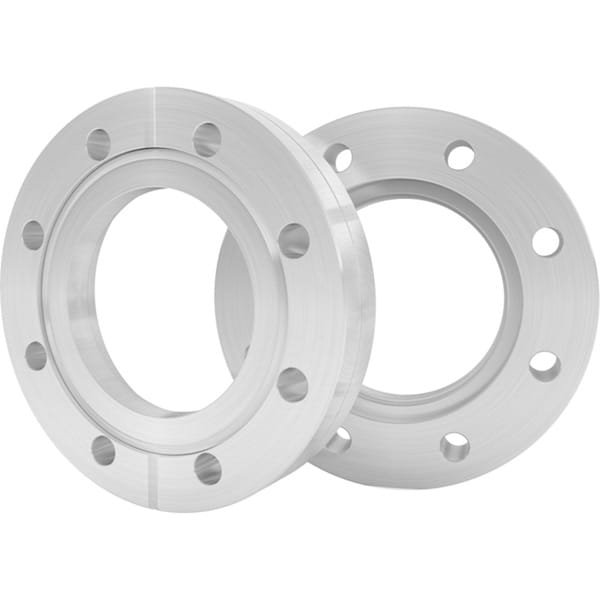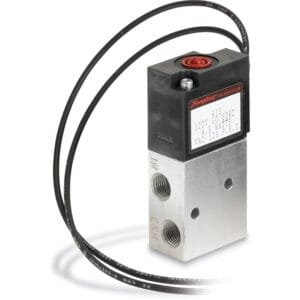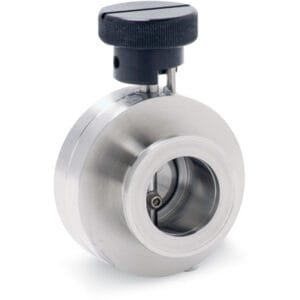Overview of ConFlat Flanges
The CF (ConFlat) flange is the most commonly utilized option for high vacuum (HV) and ultra-high vacuum (UHV) applications. This flange system supports a variety of gauges, instruments, accessories, and feedthroughs, making it an essential component in many vacuum setups.
Blank (Blind) Flange
A blank or blind flange is a solid, disc-shaped fitting employed in vacuum systems. It can be custom-machined to either create a tailored fitting or to seal off unused sections of tubing or ports on vacuum chambers, ensuring effective containment and integrity.
Seal Mechanism
The sealing mechanism of the CF flange features a knife-edge that is precision-machined below the flange’s flat surface. As the bolts of a flange pair are tightened, these knife-edges form annular grooves on each side of a soft metal gasket. The extruded metal from the gasket fills in any machining marks and surface imperfections, resulting in a leak-tight seal. The CF seal functions effectively within a pressure range of 760 torr (103 mbar) down to less than 1 x 10^-13 Torr (approximately 1.3 x 10^-13 mbar) and can operate across a temperature range of -196°C to 450°C, depending on the materials used.
In North America, flange sizes are typically referenced by their outside diameter (O.D.). Conversely, in Europe and much of Asia, the nomenclature usually references the nominal internal diameter (I.D.) of the largest tube that can be welded to a bored flange.
Types of ConFlat Flanges
ConFlat flanges are available in four primary configurations:
- Fixed Flange: This one-piece design has a bolt-hole orientation that is fixed concerning the fitting, providing stable alignment during assembly.
- Rotatable Flange: Comprising an inner weld ring and an outer bolt ring, this configuration allows the bolt ring to rotate around the inner weld ring, offering flexibility for alignment adjustments.
Both fixed and rotatable flanges come with options for through (clearance) holes or tapped holes, enabling customization to suit specific application requirements.
Through (Clearance) Holes

Are through-holes that allow adequate clearance for bolts to go through both flanges and secured by nuts or plate nuts.
Tapped Holes

Are imperial or metric threaded holes machined through the flange. This allows a clearance-hole flange to be connected without the need for nuts or plate nuts. Be aware of a components bolt hole orientation when selecting tapped flanges.
Ordering Table
| Flange Size/OD | Type | Flange Material | Part Number |
| DN16CF (1.33" OD) | Fixed Tapped | 304L SS | F0133X000NM |
| DN16CF (1.33" OD) | Fixed Tapped | 304L SS | F0133X000NT |
| DN25CF (2.13" OD) | Fixed Tapped | 304L SS | F0212X000NT |
| DN35CF-DN40CF (2.75" OD) | Fixed Tapped | 304L SS | F0275X000NM |
| DN35CF-DN40CF (2.75" OD) | Fixed Tapped | 304L SS | F0275X000NT |
| DN50CF (3.38" OD) | Fixed Tapped | 304L SS | F0337X000M |
| DN50CF (3.38" OD) | Fixed Tapped | 304L SS | F0337X000NT |
| DN63CF (4.50" OD) | Fixed Tapped | 304L SS | F0450X000NM |
| DN63CF (4.50" OD) | Fixed Tapped | 304L SS | F0450X000NT |
| DN75CF (4.63" OD) | Fixed Tapped | 304L SS | F0462X000NT |
| DN100CF (6.00" OD) | Fixed Tapped | 304L SS | F0600X000NM |
| DN100CF (6.00" OD) | Fixed Tapped | 304L SS | F0600X000NT |
| DN125CF (6.75" OD) | Fixed Tapped | 304L SS | F0675X000NT |
| DN160CF (8.00" OD) | Fixed Tapped | 304L SS | F0800X000NM |
| DN160CF (8.00" OD) | Fixed Tapped | 304L SS | F0800X000NT |
| DN200CF (10.00" OD) | Fixed Tapped | 304L SS | F1000X000NM |
| DN200CF (10.00" OD) | Fixed Tapped | 304L SS | F1000X000NT |
| DN250CF (12.00" OD) | Fixed Tapped | 304L SS | F1200X000NM |
| DN250CF (12.00" OD) | Fixed Tapped | 304L SS | F1200X000NT |
| DN275CF (13.25" OD) | Fixed Tapped | 304L SS | F1325X000NT |
| DN295CF (14.00" OD) | Fixed Tapped | 304L SS | F1400X000NT |
| DN350CF (16.50" OD) | Fixed Tapped | 304L SS | F1650X000NT |





Reviews
There are no reviews yet.